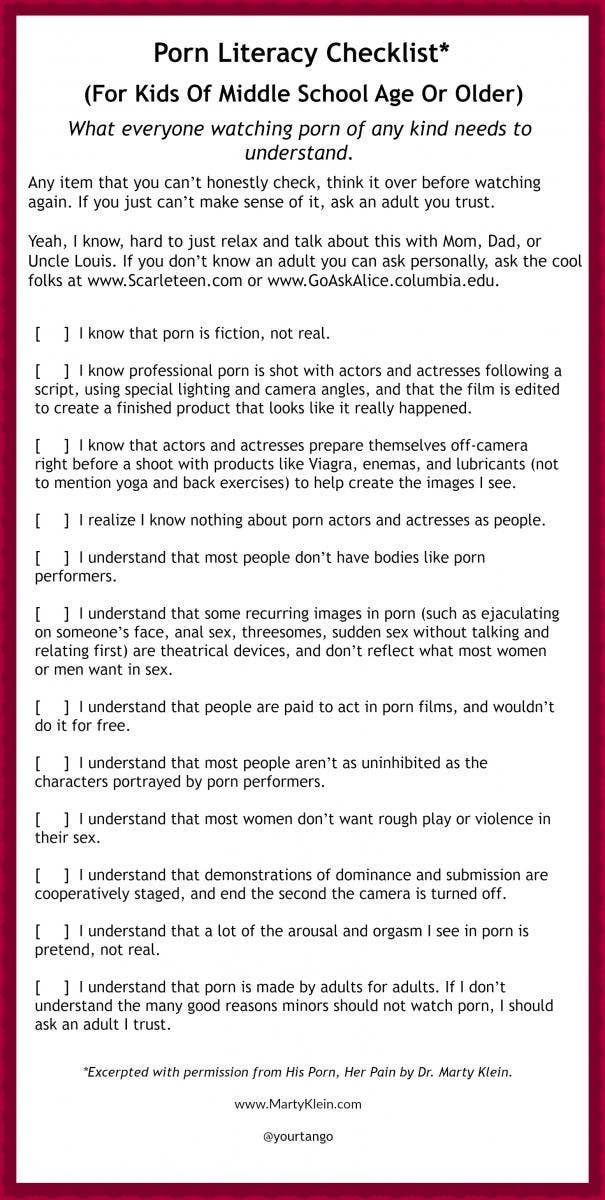The Crucial Conversation Parents Need To Have With Their Kids Before Their 13th Birthday
Bonus: A porn literacy checklist to review with your own kids.
 dimaberlinphotos
dimaberlinphotos If your kids are over 10, they’ve probably glanced at naked pictures of somebody. If your kid is 13 or older, s/he has probably looked at porn.
How much? Somewhere between once and a whole lot.
No reasonable parent is cheered by this news. That said, no parent should feel that this is the end of the world.
Let’s start from the beginning: All kids are sexual beings.
Their eroticism develops over time (like their sense of themselves as learners, friends, and siblings), and looks quite different at 15 than it does at five, when it’s vague and amorphous.
And all kids are curious about bodies: their own, others', yours.
They’ll ask questions you don’t like, they’ll peek at siblings or friends (or you!) in the shower, they’ll compare themselves to others, and they’ll touch themselves in places you might find inconvenient — Grandma’s, McDonald’s, the dentist’s office.
Kids Who Look At Naked Imagery Or Porn Generally Have More Questions Than Answers
Hopefully, they have a good relationship with you, in which they can ask questions about sex, bodies, gender, and pleasure (“Dad, do you kiss other men? Why not?” “Mom, do you like your boobs squeezed?”).
You’ll want this relationship in place — where you and your kids talk about sex as if it’s a normal subject — when they start looking at porn. Because it’s almost impossible to have a meaningful conversation about porn without talking about sex.
If you and your kid can’t do that, you’re both in trouble, because your ability to help your kid process the adult imagery that s/he sees will be very limited.
So what should we tell our kids about porn?
You don’t want your kids looking at a product made for adults. So tell them so: “I don’t think it’s good for you to look at that stuff.”
And tell them why: “It’s made for adults, who are able to understand the images and what they’re all about. Besides, most adults have had sex, so they know that porn isn’t like real sex. If you haven’t had much sexual experience, it would be hard to know that porn sex isn’t real.”
There’s no need to tell them that porn is trash, or that only bad people look at porn, or that the actresses are suffering (most aren’t).
So what do we want our kids to know about porn?
It’s not real. It’s not real. It’s not real.
It’s … acting! It’s scripted, there’s lighting and special effects, and most of all, it’s edited.
Multiple takes are fitted together to create the illusion of continuous action. Multiple angles are used to create the illusion that people defy gravity. Off-camera preparation makes things possible on screen that in real life take communication, experience, lubricants, and contraceptives, not to mention periodic resting.
And extraordinary fitness. Remind your kids that porn shows unusual bodies doing unusual things in unusual situations. Your kids are unlikely to ever find themselves facing any of the three.
Together, these messages constitute Porn Literacy.
Although we don’t want our kids to look at porn, they will — and so they need tools to understand it.
It’s just like seat belts in cars and helmets for bike riding — we don’t want our kids to get in accidents, but we want them prepared in case they do.
Here’s something you can hand to your child who’s a middle schooler or older. It will make your job much easier.
Parents, feel free to hand this to your kid, read this to your kid, or share this with your kid. And feel free to use it yourself. It applies to all people consuming pornography.

For a text-based version of this checklist, see the accompanying article: Your Kids WILL See Porn — This Checklist Makes Sure They're Prepared.
Like the fictional worlds of Harry Potter, Star Trek, and Twilight, pornography depicts a world that looks familiar but doesn’t actually exist.
It features bodies most people don’t have, doing things most people don’t do, in situations most people are never in.
It would be a big mistake to assume that you live in that world. Because sex in real life isn’t like sex in porn. It can’t be, because what we see is the product of acting and editing—not real relationships or real situations.
If you’re going to watch porn, remember that your life can’t be like the lives of the characters you see there. Real people—like you—generally don’t have as much desire, get as excited, or feel so intensely as the characters in porn. That’s because you’re real, and the characters aren’t.
Porn leaves out a lot of what most people enjoy about sex: kissing, hugging, whispering, laughing, and talking afterward. Real sex often includes words of genuine affection, which porn almost never includes. That’s because the characters in porn generally don’t feel that close to each other.
Because porn is a complex product, consuming it without understanding it can be confusing.
And because sexuality is an important part of life, getting confused about it while watching porn can cause anyone—especially young people—difficulty.
Expert Dr. Marty Klein is the author of the book His Porn, Her Pain: Confronting America’s PornPanic With Honest Talk About Sex.

